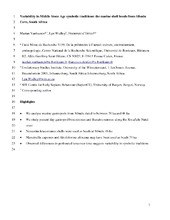| dc.contributor.author | Vanhaeren, Marian | |
| dc.contributor.author | Wadley, Lyn | |
| dc.contributor.author | d'Errico, Francesco | |
| dc.date.accessioned | 2020-04-08T08:13:49Z | |
| dc.date.available | 2020-04-08T08:13:49Z | |
| dc.date.issued | 2019 | |
| dc.Published | Vanhaeren M, Wadley L, d'Errico F. Variability in Still Bay symbolic traditions: the marine shell beads from Sibudu Cave, South Africa. Journal of Archaeological Science: Reports. 2019;27:101893 | eng |
| dc.identifier.issn | 2352-409X | |
| dc.identifier.issn | 2352-4103 | |
| dc.identifier.uri | https://hdl.handle.net/1956/21812 | |
| dc.description.abstract | Located in the KwaZulu-Natal, 15 km from the coast, Sibudu has yielded twenty-three marine gastropods, nine of which are perforated. At 70.5 ± 2.0 ka, in a Still Bay Industry, there is a cluster of perforated Afrolittorina africana shells, one of which has red ochre stains. There is also a perforated Mancinella capensis and some unperforated shells of both A. africana and M. capensis. The cluster may represent an area where the shells were processed or where apparel to which shells were attached was lost. In a Howiesons Poort layer, 64.7 ± 1.9 ka, there is a single perforated Afrolittorina africana shell. This shell may be from the Still Bay and may have been dislodged by rock fall. Two Nassarius kraussianus shells, one of them perforated and bearing traces of utilisation as a bead, were found in a late Middle Stone Age layer with an OSL age of 46.6 ± 2.3 ka. N. kraussianus was not found in older layers, even though this taxon occurs in southern Cape sites during the Middle Stone Age. Where the perforations are undamaged and suitable for microscopy, they appear to have been made by punching the shells with a pointed tool made of bone or hard wood. Such perforations have been replicated experimentally. Unlike the Blombos beads, the Sibudu shells from the Still Bay and Howiesons Poort layers bear no compelling evidence of use wear in their perforations. We therefore cannot be certain that they were suspended. However, if the Sibudu shells were beads, the changing use of taxa through time suggests variability in symbolic traditions. | en_US |
| dc.language.iso | eng | eng |
| dc.publisher | Elsevier | eng |
| dc.rights | Attribution CC BY-NC-ND | eng |
| dc.rights.uri | http://creativecommons.org/licenses/by-nc-nd/4.0/ | eng |
| dc.title | Variability in Middle Stone Age symbolic traditions: The marine shell beads from Sibudu Cave, South Africa | eng |
| dc.type | Peer reviewed | |
| dc.type | Journal article | |
| dc.date.updated | 2020-01-24T11:38:53Z | |
| dc.description.version | acceptedVersion | |
| dc.rights.holder | Copyright 2019 Elsevier | eng |
| dc.source.articlenumber | 101893 | |
| dc.identifier.doi | https://doi.org/10.1016/j.jasrep.2019.101893 | |
| dc.identifier.cristin | 1706842 | |
| dc.source.journal | Journal of Archaeological Science: Reports | |
| dc.relation.project | Norges forskningsråd: 262618 | |
| dc.identifier.citation | Journal of Archaeological Science: Reports. 2019;27:101893 | |
| dc.source.volume | 27 | |

